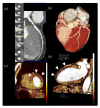CT Myocardial Perfusion Imaging: A New Frontier in Cardiac Imaging
- PMID: 30406139
- PMCID: PMC6204157
- DOI: 10.1155/2018/7295460
CT Myocardial Perfusion Imaging: A New Frontier in Cardiac Imaging
Abstract
The past two decades have witnessed rapid and remarkable technical improvement of multidetector computed tomography (CT) in both image quality and diagnostic accuracy. These improvements include higher temporal resolution, high-definition and wider detectors, the introduction of dual-source and dual-energy scanners, and advanced postprocessing. Current new generation multidetector row (≥64 slices) CT systems allow an accurate and reliable assessment of both coronary epicardial stenosis and myocardial CT perfusion (CTP) imaging at rest and during pharmacologic stress in the same examination. This novel application makes CT the unique noninvasive "one-stop-shop" method for a comprehensive assessment of both anatomical coronary atherosclerosis and its physiological consequences. Myocardial CTP imaging can be performed with different approaches such as static arterial first-pass imaging, and dynamic CTP imaging, with their own advantages and disadvantages. Static CTP can be performed using single-energy or dual-energy CT, employing qualitative or semiquantitative analysis. In addition, dynamic CTP can obtain quantitative data of myocardial blood flow and coronary flow reserve. The purpose of this review was to summarize all available evidence about the emerging role of myocardial CTP to identify ischemia-associated lesions, focusing on technical considerations, clinical applications, strengths, limitations, and the more promising future fields of interest in the broad spectra of ischemic heart disease.
Figures



Similar articles
-
Computed tomography stress myocardial perfusion imaging in patients considered for revascularization: a comparison with fractional flow reserve.Eur Heart J. 2012 Jan;33(1):67-77. doi: 10.1093/eurheartj/ehr268. Epub 2011 Aug 2. Eur Heart J. 2012. PMID: 21810860
-
CT myocardial perfusion imaging: current status and future perspectives.Int J Cardiovasc Imaging. 2017 Jul;33(7):1009-1020. doi: 10.1007/s10554-017-1102-6. Epub 2017 Mar 9. Int J Cardiovasc Imaging. 2017. PMID: 28281025 Review.
-
Rationale and design of advantage (additional diagnostic value of CT perfusion over coronary CT angiography in stented patients with suspected in-stent restenosis or coronary artery disease progression) prospective study.J Cardiovasc Comput Tomogr. 2018 Sep-Oct;12(5):411-417. doi: 10.1016/j.jcct.2018.06.003. Epub 2018 Jun 18. J Cardiovasc Comput Tomogr. 2018. PMID: 29933938
-
CAD detection in patients with intermediate-high pre-test probability: low-dose CT delayed enhancement detects ischemic myocardial scar with moderate accuracy but does not improve performance of a stress-rest CT perfusion protocol.JACC Cardiovasc Imaging. 2013 Oct;6(10):1062-1071. doi: 10.1016/j.jcmg.2013.04.013. Epub 2013 Sep 4. JACC Cardiovasc Imaging. 2013. PMID: 24011773
-
CT Assessment of Myocardial Perfusion and Fractional Flow Reserve.Prog Cardiovasc Dis. 2015 May-Jun;57(6):623-31. doi: 10.1016/j.pcad.2015.03.003. Epub 2015 Mar 12. Prog Cardiovasc Dis. 2015. PMID: 25770850 Review.
Cited by
-
Clinical Applications of Wide-Detector CT Scanners for Cardiothoracic Imaging: An Update.Korean J Radiol. 2019 Dec;20(12):1583-1596. doi: 10.3348/kjr.2019.0327. Korean J Radiol. 2019. PMID: 31854147 Free PMC article. Review.
-
Pathophysiologic Basis and Diagnostic Approaches for Ischemia With Non-obstructive Coronary Arteries: A Literature Review.Front Cardiovasc Med. 2022 Mar 17;9:731059. doi: 10.3389/fcvm.2022.731059. eCollection 2022. Front Cardiovasc Med. 2022. PMID: 35369287 Free PMC article. Review.
-
Dynamic CT myocardial perfusion without image registration.Sci Rep. 2022 Jul 23;12(1):12608. doi: 10.1038/s41598-022-16573-w. Sci Rep. 2022. PMID: 35871187 Free PMC article.
-
Cardiac Allograft Vasculopathy: Challenges and Advances in Invasive and Non-Invasive Diagnostic Modalities.J Cardiovasc Dev Dis. 2024 Mar 21;11(3):95. doi: 10.3390/jcdd11030095. J Cardiovasc Dev Dis. 2024. PMID: 38535118 Free PMC article. Review.
-
The Non-Invasive Diagnosis of Chronic Coronary Syndrome: A Focus on Stress Computed Tomography Perfusion and Stress Cardiac Magnetic Resonance.J Clin Med. 2023 May 31;12(11):3793. doi: 10.3390/jcm12113793. J Clin Med. 2023. PMID: 37297986 Free PMC article. Review.
References
-
- Yang L., Zhou T., Zhang R., et al. Meta-analysis: diagnostic accuracy of coronary CT angiography with prospective ECG gating based on step-and-shoot, Flash and volume modes for detection of coronary artery disease. European Radiology. 2014;24(10):2345–2352. doi: 10.1007/s00330-014-3221-y. - DOI - PubMed
-
- Mark D. B., Berman D. S., Budoff M. J. CCF/ACR/AHA/NASCI/SAIP/SCAI/SCCT 2010 expert consensus document on coronary computed tomographic angiography: a report of the American College of Cardiology Foundation Task Force on Expert Consensus Documents. Circulation. 2010;121(22):2509–2543. doi: 10.1161/CIR.0b013e3181d4b618. - DOI - PubMed
-
- Fihn S. D., Blankenship J. C., Alexander K. P., Bittl J. A., et al. 2014 ACC/AHA/AATS/PCNA/SCAI/STS focused update of the guideline for the diagnosis and management of patients with stable ischemic heart disease: a report of the American College of Cardiology/American Heart Association Task Force on Practice Guidelines, and the American Association for Thoracic Surgery, Preventive Cardiovascular Nurses Association, Society for Cardiovascular Angiography and Interventions, and Society of Thoracic Surgeons. Circulation. 2014;130:1749–1767. - PubMed
Publication types
MeSH terms
LinkOut - more resources
Full Text Sources
Other Literature Sources
Miscellaneous

